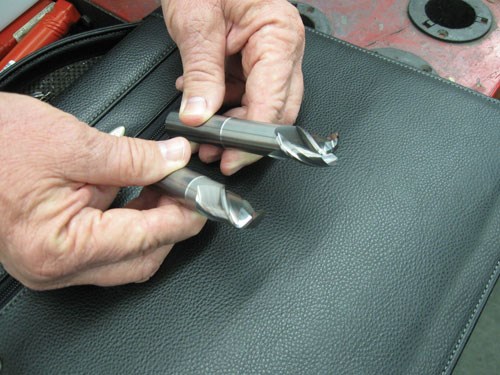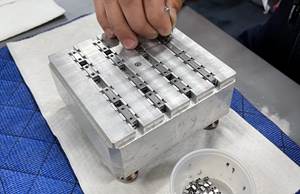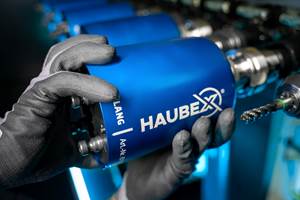How do you get 60 tools to run 142 part numbers? For Precise Machining & Manufacturing of Tulsa, Oklahoma, answering that question was key to dramatically improving productivity in the production of aluminum aircraft parts.
A contract manufacturer specializing in aerospace work, Precise recently installed a pallet system from Makino for machining various aluminum components related to the Boeing 737. The automated system consists of six Makino a61 horizontal machining centers sharing a row of 26 pallets. The virtue of such a system is the way it makes use of time the company would have lost, back when it manufactured the parts on stand-alone machines. For example, all the machines can keep cutting while operators stage work at the system’s load/unload stations. The machines can also keep cutting through long, unattended night shifts, with pallets automatically sent to the machines until all the work in the queue has been run. Thanks to these advantages, the six-machine cell processes work at a rate that formerly required two to three times as many machine tools to achieve.
But getting to this level of productivity did entail challenges. Processes had to be re-engineered for the pallet-system machines. In particular, the choices in cutting tools had to change, because each machine has capacity for only 60 tools. That capacity might seem like plenty on a stand-alone machining center, because the operator can load different tools with each new part’s setup. In the pallet system, though, an operator doesn’t touch the machine as frequently. Whatever cutters are in the machine have to be sufficient to run the entire series of part numbers that will shuttle in before the operator returns. Plus, in order for the machines to be interchangeable, they have to have the same selection of tools in each magazine. Owing to these factors, Precise’s best choice was to find one standard set of 60 tools that could machine any of the system’s part numbers. To do this, Precise had to dramatically prune the number of cutters from which its engineers can choose.
Wes Viddaurri is one of the Precise employees staffing the pallet system area. He also used to machine some of the same part numbers on stand-alone machines. He says one of the more important ways the parts’ processes have been re-engineered relates to machining holes. Many that used to be drilled and reamed, and sometimes center drilled before either of these steps, are now machined through helical interpolation milling. For one hole, an end mill used in this way can replace three tools. Yet the replacement is even larger than this, because that one end mill can machine various hole sizes. Thanks to helical milling, the shop has been able to eliminate eight different holemaking tools from the pallet-system tool magazine, allowing the work of these tools to be done by a single 1/4-inch end mill.
Yet getting the standard tool set down to 60 meant consolidating milling tools as well. After keeping many tools that couldn’t be eliminated because of their application to unusual features, the shop was left with very few positions for general material removal. Therefore, across all the part numbers run in the pallet system, Precise now does most of its basic milling work with just three tools. They are a face mill from Seco Tools and two 3/4-inch end mill styles from Gorilla Mill.
Toolroom manager Randy Miller says the latter tools were customized for Precise’s needs. A custom lead angle on the end mills seemed to deliver better performance in the shop’s processes. Gorilla Mill worked with the shop to tailor the angle accordingly. In addition, the shop specifies particular lengths that were chosen carefully. Looking at all the part numbers run on the pallet-system machines, he says the company determined that two specific lengths would extend the cutters far enough to reach the maximum number of features, while still keeping the tools short enough to maintain acceptable stability. Thus, the tool vendor now supplies the end mills to Precise in the non-standard lengths of 1.8 inch for a two-flute tool, and 2.8 inches for a tool with three flutes.
Mr. Viddaurri says consolidating the number of tools has also proven valuable for reasons beyond just getting more part numbers into the system. Another benefit of having fewer tools relates to troubleshooting an unattended process. If parts are trending out of tolerance, then having fewer tools limits the number of factors that need to be examined in search of the cause.
Still another benefit relates to optimizing the process. A shop that routinely uses hundreds of tools probably does not have a hope of understanding all of them well. But when a much smaller number of tools do most of the work, the shop is much better able to understand each of them. With just three tools doing much of the pallet system’s milling, Precise has been able to learn precisely what speed and feed rate it can achieve from each of these tools in various cutting conditions, and what tool life to expect. Because these few cutters are so vital, the shop has been able to maximize the value it gets from each one.

.jpg;width=70;height=70;mode=crop)













.png;maxWidth=300;quality=90)











